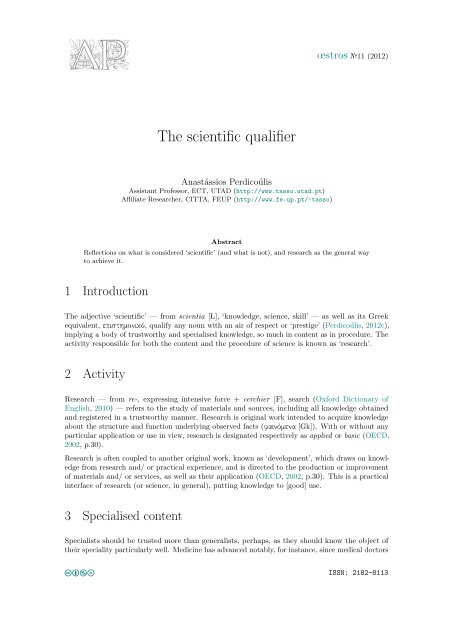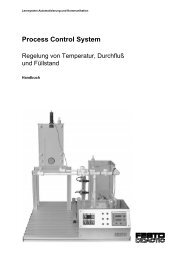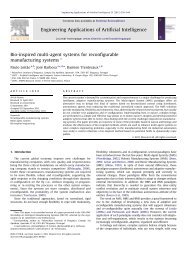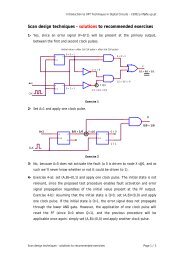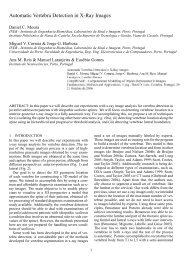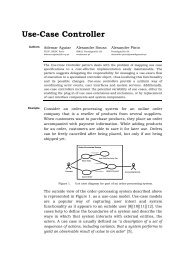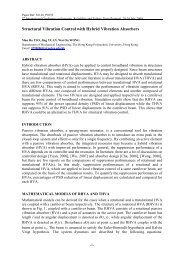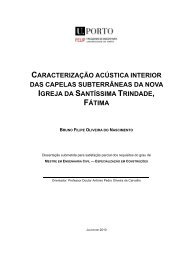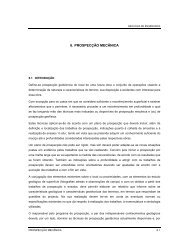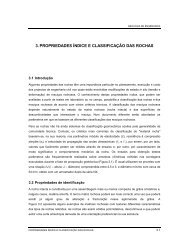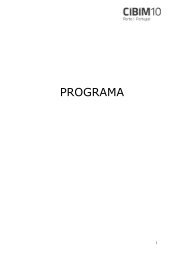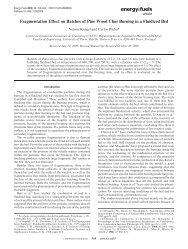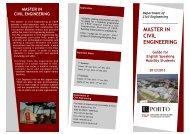The scientific qualifier
The scientific qualifier
The scientific qualifier
You also want an ePaper? Increase the reach of your titles
YUMPU automatically turns print PDFs into web optimized ePapers that Google loves.
AP<br />
œstros №11 (2012)<br />
<strong>The</strong> <strong>scientific</strong> <strong>qualifier</strong><br />
Anastássios Perdicoúlis<br />
Assistant Professor, ECT, UTAD (http://www.tasso.utad.pt)<br />
Affiliate Researcher, CITTA, FEUP (http://www.fe.up.pt/~tasso)<br />
Abstract<br />
Reflections on what is considered ‘<strong>scientific</strong>’ (and what is not), and research as the general way<br />
to achieve it.<br />
1 Introduction<br />
<strong>The</strong> adjective ‘<strong>scientific</strong>’ — from scientia [L], ‘knowledge, science, skill’ — as well as its Greek<br />
equivalent, επιστημονικό, qualify any noun with an air of respect or ‘prestige’ (Perdicoúlis, 2012c),<br />
implying a body of trustworthy and specialised knowledge, so much in content as in procedure. <strong>The</strong><br />
activity responsible for both the content and the procedure of science is known as ‘research’.<br />
2 Activity<br />
Research — from re-, expressing intensive force + cerchier [F], search (Oxford Dictionary of<br />
English, 2010) — refers to the study of materials and sources, including all knowledge obtained<br />
and registered in a trustworthy manner. Research is original work intended to acquire knowledge<br />
about the structure and function underlying observed facts (φαινόμενα [Gk]). With or without any<br />
particular application or use in view, research is designated respectively as applied or basic (OECD,<br />
2002, p.30).<br />
Research is often coupled to another original work, known as ‘development’, which draws on knowledge<br />
from research and/ or practical experience, and is directed to the production or improvement<br />
of materials and/ or services, as well as their application (OECD, 2002, p.30). This is a practical<br />
interface of research (or science, in general), putting knowledge to [good] use.<br />
3 Specialised content<br />
Specialists should be trusted more than generalists, perhaps, as they should know the object of<br />
their speciality particularly well. Medicine has advanced notably, for instance, since medical doctors<br />
cbnd ISSN: 2182-8113
<strong>The</strong> <strong>scientific</strong> <strong>qualifier</strong><br />
A. Perdicoúlis<br />
œstros №11 (2012)<br />
Latest edition: November 29, 2013<br />
started specialising. But as they gain focus or expertise in a narrow field of subjects, specialists<br />
may lose perspective or the ‘wider picture’ (Figure 1) — e.g. the patient as a person.<br />
knowledge<br />
subjects<br />
Figure 1<br />
Some people specialise more (dotted line) and others less (solid line)<br />
Specialisation can be taken to extremes, always relying on ‘more specialists’ to ‘know better’.<br />
A notable case is that of scientists and the assessment of quality of academic publications, in<br />
which case they eventually turn to meta-information specialists: the indexing and ranking services<br />
(Perdicoúlis, 2013a). Super specialisation departs from the realm of reality into a meta-reality —<br />
from an object to its ‘shadow’ — that is capable of taking over as a new reality (Perdicoúlis, 2013c).<br />
Hence, deep specialisation may provoke an alienation from the context of reality.<br />
People with ‘broader’ knowledge (Figure 1) are rare nowadays, but have been popular and appreciated<br />
in the past — for instance, in the classic antiquity (e.g. Socrates, Plato, Aristotle) and in the<br />
renaissance (e.g. Leonardo, Galileo). It should be true that the amount of knowledge in the 21st C.<br />
AD is much greater than in the antiquity or renaissance, and it could be argued that people do<br />
not have the time to absorb and retain so much information. So, they may try to excel through<br />
specialisation, at the cost of losing the ‘big picture’ from sight.<br />
4 Procedure<br />
Scientific also refers to the way that knowledge is obtained — that is, the method or procedure<br />
(Perdicoúlis, 2012b) — as well as the way this knowledge is registered and transmitted. Obtaining<br />
knowledge in a trustable way is safeguarded by the <strong>scientific</strong> protocol (Perdicoúlis and Glasson,<br />
2006), presented as a concise process diagram (Perdicoúlis, 2011b) in Figure 2.<br />
Start<br />
Finish<br />
hypothesis<br />
set up<br />
experiment<br />
test<br />
outcome<br />
accept<br />
theory<br />
reject<br />
Figure 2<br />
Synopsis of the <strong>scientific</strong> protocol<br />
At the beginning and at the end of the <strong>scientific</strong> protocol (Figure 2) lies the same ‘general rule’:<br />
first as a hypothesis, and — after rigorous testing and approval — then as a theory. <strong>The</strong> formulation<br />
2/5
<strong>The</strong> <strong>scientific</strong> <strong>qualifier</strong><br />
A. Perdicoúlis<br />
œstros №11 (2012)<br />
Latest edition: November 29, 2013<br />
of this general rule (by induction) and its application or use (by deduction) involve meticulous<br />
transformations of information (Perdicoúlis, 2012d; Perdicoúlis and Glasson, 2006) — Figure 3.<br />
O 1<br />
I 1<br />
Induction<br />
Deduction<br />
I 5 O 5<br />
I 2<br />
I 3<br />
I 4<br />
General<br />
Rule<br />
O 2<br />
O 3<br />
O 4<br />
Individual<br />
Observations<br />
Individual Predictions,<br />
Instructions, or Conclusions<br />
Figure 3<br />
Induction and deduction in the formulation of a general rule to be used in the <strong>scientific</strong> protocol<br />
Karl Popper, the founder of <strong>scientific</strong> testing and ‘falsification’ of hypotheses (Chalmers, 1999,<br />
pp.59–86), argues that no amount of empirical observation can ever conclusively verify a hypothesis<br />
(Perdicoúlis, 2012a), but a single observation can falsify it. Simply put, Popper — and subsequently<br />
the entirety of science since the second half of the 20th C. — denies verification in favour of<br />
falsification of hypotheses (Kuhn, 1996, p.146). Hence, science does not aim to accumulate evidence<br />
to support a certain hypothesis, but rather to disprove it.<br />
Falsification of hypotheses gives importance to rigorous and ruthless testing, and meticulous<br />
procedural protocols to accompany these tests. Laboratories are elevated to high status as the<br />
testing grounds for many of the natural sciences. As a consequence, the conception or creation of<br />
hypotheses passes to an obscure background; hypotheses are ‘freely created by the human intellect’<br />
(Chalmers, 1999, p.60), with all the confidence that <strong>scientific</strong> testing will trustfully refute the ‘wrong’<br />
ones.<br />
After securing trustworthy knowledge through the <strong>scientific</strong> protocol, this knowledge needs to<br />
be registered and transmitted appropriately. This feat — at least in principle — entails a large,<br />
worldwide system of research centres, databases, publications, and teaching institutions. At least<br />
the communicative part, which is the <strong>scientific</strong> writing (Perdicoúlis, 2012e), is expected to exhibit<br />
some quality standards (Perdicoúlis, 2013d) such as: (a) traceability, so that trustworthiness of<br />
content can be traced back to the sources, (b) objectivity, even when handling value judgements, (c)<br />
precision, or coherence of facts and arguments, and (d) accuracy, or being ‘to the point’ (Perdicoúlis,<br />
2012e).<br />
5 Challenges<br />
In this context, the first challenge is to specialise and also keep the ‘big picture’ in view. This<br />
may mean the renaissance man (and this time, also the woman) is back. This is a great personal<br />
investment for many, as well as for institutions — both research and teaching.<br />
Another challenge is <strong>scientific</strong> communication — mainly writing, which is the more permanent<br />
kind, as it constitutes records to be used as sources. <strong>The</strong> intent is to preserve what has been<br />
discovered and known, as ‘<strong>scientific</strong>ally’ as possible. As many people are involved in writing, and<br />
thus transmitting information about knowledge, everyone of these authors must be aware of the<br />
responsibility to write ‘<strong>scientific</strong>ally’ (Perdicoúlis, 2012e) — but are they taught this at school or at<br />
the university? Are the teachers prepared for this?<br />
3/5
<strong>The</strong> <strong>scientific</strong> <strong>qualifier</strong><br />
A. Perdicoúlis<br />
œstros №11 (2012)<br />
Latest edition: November 29, 2013<br />
Without a doubt, the way of obtaining trustworthy knowledge is cornerstone. <strong>The</strong> current <strong>scientific</strong><br />
method, based on hypothesis testing and falsification, has made much progress worldwide, but has<br />
far-reaching implications for science and humanity — beyond those of producing or verifying (oddly,<br />
through falsification) <strong>scientific</strong> knowledge. First, we tend to ignore or disregard age-old human<br />
knowledge (Perdicoúlis, 2013b), as if it had no value at all. <strong>The</strong> challenge is how to make use of<br />
personal and collective human knowledge into science. How can the two parts meet?<br />
A second implication of the current <strong>scientific</strong> method is that the creative part of the human intellect,<br />
responsible for the formulation of hypotheses (inductive thinking) becomes under-developed due to<br />
lack of attention and/ or its inferior status (Perdicoúlis, 2012d). Since <strong>scientific</strong> testing is a selection<br />
process, and selection is ‘as good as the best option available’ (Perdicoúlis, 2011a, p.142), it makes<br />
sense to direct every effort towards creating better hypotheses. Thus, the second challenge is how to<br />
complement or combine the deductive thinking of falsification and its intensive/ exhaustive testing<br />
with the creative inductive thinking that produces hypotheses. Possible models may be sought in<br />
established — although not ‘<strong>scientific</strong>’ — practices, such as inter alia engineering, architecture, the<br />
fine arts, and even detective work (Perdicoúlis, 2012d).<br />
Finally, a look at the impostors. Popular culture, such as that created by the social media and the<br />
entertainment business, often employs special appearances to convey the confidence of ‘<strong>scientific</strong>’ —<br />
for instance, the addition of a grid, simulating graph paper, may give a sense of laboratory-grade<br />
to products such as toothpaste; measurements, indices, and unusual words elevate the degree<br />
of difficulty (and, apparently, specialisation) of information, and this remoteness with an air of<br />
erudition or scholarship makes practically anything look ‘<strong>scientific</strong>’. Caveat emptor.<br />
References<br />
Chalmers, A.F. (1999) What is This Thing Called Science? (3rd ed). Buckingham: Open University<br />
Press<br />
Kuhn, T.S. (1996) <strong>The</strong> Structure of Scientific Revolutions (3rd ed). Chicago: <strong>The</strong> University of<br />
Chicago.<br />
OECD (2002) Frascati Manual: Proposed Standard Practice for Surveys on Research and Experimental<br />
Development. Paris: OECD Publications.<br />
Oxford Dictionary of English, 3 rd ed. (2010). Oxford: Oxford University Press.<br />
Perdicoúlis, A. (2013d) On quality. œstros, 10.<br />
Perdicoúlis, A. (2013c) Shadow measurements. œstros, 9.<br />
Perdicoúlis, A. (2013b) People know. œstros, 8.<br />
Perdicoúlis, A. (2013a) Educated readership. œstros, 7.<br />
Perdicoúlis, A. (2012e) Scientific writing. œstros, 5.<br />
Perdicoúlis, A. (2012d) Detective work. œstros, 4.<br />
Perdicoúlis, A. (2012c) Senses. ETYMOS, 4.<br />
Perdicoúlis, A. (2012b) Movement. ETYMOS, 3.<br />
Perdicoúlis, A. (2012a) Entity and place. ETYMOS, 2.<br />
4/5
<strong>The</strong> <strong>scientific</strong> <strong>qualifier</strong><br />
A. Perdicoúlis<br />
œstros №11 (2012)<br />
Latest edition: November 29, 2013<br />
Perdicoúlis, A. (2011b) Application manual for the ‘Systems Thinking’ book. Systems Planner, 2.<br />
Perdicoúlis, A. (2011a) Building Competences for Spatial Planners: Methods and Techniques for<br />
Performing Tasks with Efficiency. London: Routledge.<br />
Perdicoúlis, A., and J. Glasson (2006) Causal networks in EIA. Environmental Impact Assessment<br />
Review, 26:553–569.<br />
<br />
5/5


